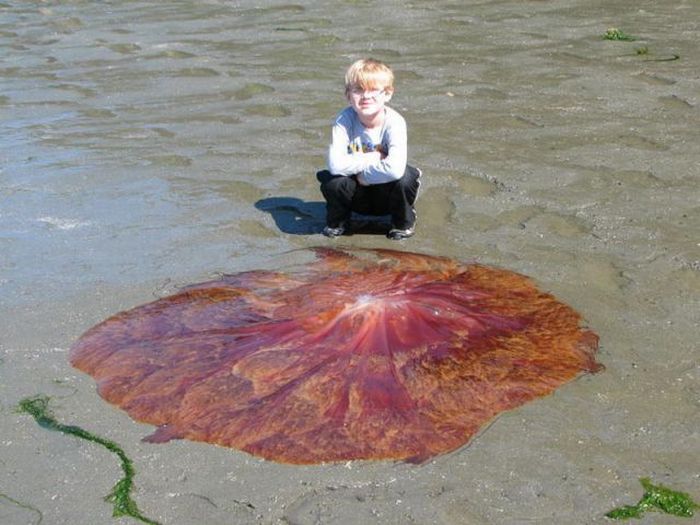|
|
Giant Jellyfish, Kayak Point, Washington, United States
|
Jellyfish are usually either male or female (occasionally hermaphroditic specimens are found). In most cases, both release sperm and eggs into the surrounding water, where the (unprotected) eggs are fertilized and mature into new organisms. In a few species, the sperm swim into the female's mouth fertilizing the eggs within the female's body where they remain for the early stages of development. In moon jellies, the eggs lodge in pits on the oral arms, which form a temporary brood chamber for the developing planula larvae.
Most jellyfish undergo two distinct life history stages (body forms) during their life cycle. The first is the polypoid stage. After fertilization and initial growth, a larval form, called the planula, develops. The planula is a small larva covered with cilia. It settles onto a firm surface and develops into a polyp. The polyp is generally a small stalk with a mouth surrounded by upward-facing tentacles like miniatures of the closely related anthozoan polyps (sea anemones and corals), also of the phylum Cnidaria. This polyp may be sessile, living on the bottom or on similar substrata such as floats or boat-bottoms, or it may be free-floating or attached to tiny bits of free-living plankton or rarely, fish or other invertebrates. Polyps may be solitary or colonial, and some bud asexually by various means, making more polyps. Most are very small, measured in millimeters.
After a growth interval, the polyp begins reproducing asexually by budding and, in the Scyphozoa, is called a segmenting polyp, or a scyphistoma. New scyphistomae may be produced by budding or new, immature jellies called ephyrae may be formed. A few jellyfish species can produce new medusae by budding directly from the medusan stage. Budding sites vary by species; from the tentacle bulbs, the manubrium (above the mouth), or the gonads of hydromedusae. A few of species of hydromedusae reproduce by fission (splitting in half).
In the second stage, the tiny polyps asexually produce jellyfish, each of which is also known as a medusa. Tiny jellyfish (usually only a millimeter or two across) swim away from the polyp and then grow and feed in the plankton. Medusae have a radially symmetric, umbrella-shaped body called a bell, which is usually supplied with marginal tentacles - fringe-like protrusions from the bell's border that capture prey. A few species of jellyfish do not have the polyp portion of the life cycle, but go from jellyfish to the next generation of jellyfish through direct development of fertilized eggs.
|
|









